Two studies comparing intra-articular injections used to relieve the pain of knee osteoarthritis have found that corticosteroid injections were associated with the progression of the disease compared to hyaluronic acid.
Results of both studies were presented at the annual meeting of the Radiological Society of North America.
In the first study, researchers at the University of California, San Francisco reviewed data from 210 Osteoarthritis Initiative participants, 70 of whom received intraarticular injections, and a control group of 140 who did not receive injections during a two-year period.
Of the 70 patients who received injections, 44 received a single injection of corticosteroid, and 26 received hyaluronic acid. The treatment and control groups were matched by age, sex, body mass index, pain and physical activity scores, and severity of disease.
MRI was performed on all patients at the time of the injection and two years before and after. The MRI scans were assessed using whole-organ magnetic resonance imaging score (WORMS), a grading system for knee osteoarthritis that focuses on the meniscus, bone marrow lesions, cartilage, joint effusion and ligaments.
The researchers assessed osteoarthritis progression by comparing the imaging scores from the initial scans and two-year follow-up scans.
Significant association was found between corticosteroid injection and post-injection progression of OA (WORMS) over two years for the knee overall (p=0.03), lateral meniscus (p=0.02), lateral cartilage (p=0.03) and medial cartilage (p=0.002).
No significant association (p > 0.05) was found between hyaluronic acid injection and post-injection progression of OA. And compared to the control group, the group who received hyaluronic injections showed a decreased progression of osteoarthritis, specifically in bone marrow lesions.
No significant association was found between either injection type and progression of pain over 2 years quantified by WOMAC (p > 0.05). No significant difference (p > 0.05) was found in progression of OA over the two years prior to injection for corticosteroid and hyaluronic acid injections.
“This is the first direct comparison of corticosteroid and hyaluronic acid injections using the semi-quantitative, whole organ assessment of the knee with MRI,” said study investigator Dr Upasana Upadhyay Bharadwaj, a research fellow in the Department of Radiology at the university.
“While both corticosteroid and hyaluronic acid injections are reported to help with symptomatic pain relief for knee osteoarthritis, our results conclusively show that corticosteroids are associated with significant progression of knee osteoarthritis up to two years post-injection and must be administered with caution,” she said.
“Hyaluronic acid, on the other hand, may slow down progression of knee osteoarthritis and alleviate long term effects while offering symptomatic relief.”
“Knowing the long-term effects of these injections will help osteoarthritis patients and clinicians make more informed decisions for managing the disease and the pain it causes,” Dr Bharadwaj added.
 In the second study, researchers at the Chicago Medical School of Rosalind Franklin University of Medicine and Science conducted a case-control study comparing the radiographic progression of osteoarthritis in patients who received injections of corticosteroids and hyaluronic acid.
In the second study, researchers at the Chicago Medical School of Rosalind Franklin University of Medicine and Science conducted a case-control study comparing the radiographic progression of osteoarthritis in patients who received injections of corticosteroids and hyaluronic acid.
Researchers selected a cohort of 150 patients with similar baseline characteristics from the Osteoarthritis Initiative database, including 50 patients who received corticosteroid injections, 50 who received hyaluronic acid injections, and 50 who were not injected over a 36-month time period. The groups were matched by sex, body mass index and X-ray findings.
Patients underwent X-ray imaging of the knee at baseline and two years later. The researchers analysed the X-ray imaging, including joint space narrowing, Kellgren Lawrence (KL) grade, osteophyte formation in tibia/femur medial/lateral compartment, and sclerosis in tibia/femur medial/lateral compartment.
Compared to patients who received an injection of hyaluronic acid or no treatment at all, patients injected with corticosteroids had significantly more osteoarthritis progression, including medial joint space narrowing.
At 48-months, average KL grade was 2.79±.832 in the in the corticosteroid group, 2.11±1.35 in the hyaluronic acid groups, and 2.37±1.202 (p<0.001) in the control groups.
Intragroup comparison showed significant difference in KL grade at 48-months between corticosteroid and hyaluronic acid patients (p=.008) and significant difference between corticosteroid and control patients (p=0.004). Medial compartment joint space narrowing in the corticosteroid group was 1.56±1.02, HA 1.11±1.16, and control 1.18±1.12 (p<0.001), with significant difference between the corticosteroid and control groups (p<.001). Other dependent variables were not significant.
“Even though imaging findings for all patients were similar at baseline, the imaging hallmarks of osteoarthritis were worse two years later in patients who received corticosteroid injections compared to patients who received hyaluronic acid injections or no treatment at all,” said study investigator Dr Azad Darbandi.
“The results suggest that hyaluronic acid injections should be further explored for the management of knee osteoarthritis symptoms, and that steroid injections should be utilised with more caution.”